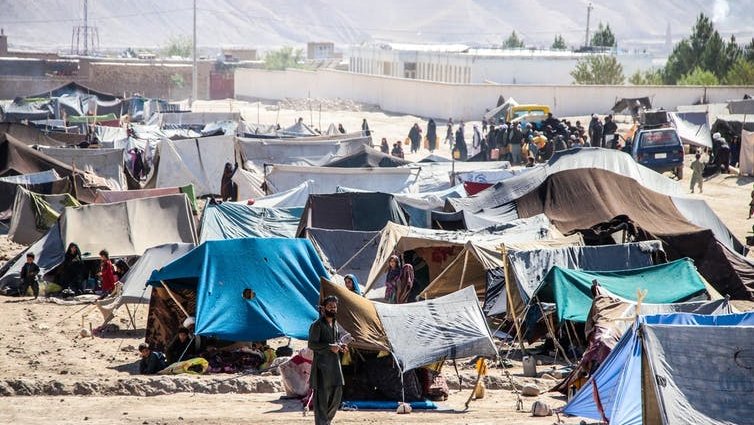The pandemic has had a big impact on Afghanistan. There have been 177,000 confirmed COVID cases and 7,600 deaths up to March 28 2022, though this is probably a significant under-count. Modelling by the Institute for Health Metrics and Evaluation – although also unlikely to be highly accurate given the paucity of real-time data for Afghanistan – estimates that COVID had already killed close to 200,000 people by the beginning of 2022.
Since August 2021, the backdrop to Afghanistan’s pandemic has been the return of the fundamentalist Taliban as the political power in charge of the country. Thousands of civilians have fled the oppressive new regime, with over 10,000 people fleeing to Tajikistan alone. This adds to the 2.2 million refugees already living in neighbouring Iran and Pakistan, who had left the country in recent years due to its instability. Thousands have also been displaced internally since the Taliban gained power.
This creates a health problem. Disease outbreaks among these refugees and displaced people are highly likely. Crowded indoor settings of emergency shelters provide ideal conditions for infections to spread, including respiratory diseases like measles and COVID, as well as conditions such as diarrhoea and scabies.
Low COVID protection then compounds the issue. Only 11% of Afghanistan’s population is estimated to be double vaccinated against COVID. Unavailability of vaccines, hesitancy, illiteracy and the destabilising impact of the Taliban are all contributing factors to low vaccine uptake.
Healthcare is collapsing
Even for those who haven’t been displaced, COVID poses a significant risk. Adding to the problem of low vaccine coverage, Afghanistan is a low-income country, and its health system was already fragmented and had limited capacity before the rise of COVID and the return of the Taliban. In particular, it lacked a strong surveillance system to track the spread of disease.
Since the Taliban takeover, the health system has started to crumble, as funding and support from international organisations has slowed down or halted altogether. COVID hospitals, for example, are struggling to function due to a lack of resources and staff. There’s thought to be only one COVID healthcare facility in the capital, Kabul – a city of approximately 4 million people.
Without significant external support, disease control will be extremely difficult. Healthcare workers are not always being paid on time – or at all. Deliveries of medical supplies, including vaccines, are erratic, as is the distribution of vaccines around the country to local health centres. Access to oxygen – important in reducing risk of death among people hospitalised with COVID – is difficult due to severely limited supplies.
Trent Inness/Shutterstock
And while there is no clear evidence of nurses and doctors being threatened, polio vaccinators have recently been killed in the country, indicating just how dangerous life can be for healthcare workers in some areas. The Taliban has long accused polio vaccination campaigns in Afghanistan and Pakistan of being fronts for spying (following the US using fake vaccination campaigns as cover when searching for Osama Bin Laden) and has targeted vaccinators repeatedly over the last decade.
Female health workers also need to be assured that they can work safely in hospitals and will be paid on time under the new regime, given the restrictions the Taliban have placed on women’s freedom to work. Resourcing issues aside, just delivering healthcare and disease protection is, at this time, a struggle.
What will happen next?
Given the high susceptibility of the Afghan population to COVID, we can expect to see cases rise. Omicron will also probably drive up cases.
A high COVID burden in children could be a particular issue this year. The United Nations estimated in late 2021 that 3.2 million Afghan children would suffer from acute malnutrition during this winter just past. This creates an additional risk factor for developing more severe COVID. The coincidence of malnutrition and respiratory disease can be hugely damaging. Child mortality rates for all causes of pneumonia are already hugely elevated in Afghanistan, it being the third biggest killer of children under five in 2018 and responsible for 15% of child deaths.
We can also expect to see other vaccine-preventable diseases become more common. Where health services are unable to function, routine vaccine coverage is greatly reduced. There is often a relatively immediate impact, with more infectious diseases, like measles, soon spreading more easily.
The existing humanitarian crises in Afghanistan, alongside the pandemic, will continue to pose a threat to health well into the future. It may be that the invasion of Ukraine draws international attention away from other refugee crises, such as Afghanistan’s. It’s therefore perhaps even more urgent that the health of all displaced and refugee populations remains a top priority of the world’s governments and global health funders.
![]()
Michael Head has received funding from the Bill & Melinda Gates Foundation and the UK Department for International Development.
Mohammad Yasir Essar does not work for, consult, own shares in or receive funding from any company or organisation that would benefit from this article, and has disclosed no relevant affiliations beyond their academic appointment.











